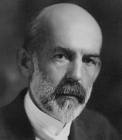Charles Horton Cooley 1864 - 1929
March 22, 2008
 Charles Horton
Cooley 1864 - 1929 was a
famous American sociologist.
Charles Horton
Cooley 1864 - 1929 was a
famous American sociologist.
Charles was the son of Thomas McIntyre Cooley, Dean of the University of Michigan Law School. He married Elsie Jones, the daughter of Samuel A Jones, Dean and Professor of Materia Medica and Therapeutics at the Homeopathic Medical College at the University of Michigan.
Cooley was born in Ann Arbor, Michigan in 1864 as the fourth of six children. At the time of his birth, his father Thomas Cooley was a Supreme Court Justice in Michigan and a professor of law. Thomas McIntyre Cooley was a highly successful man, later well known nationally for several legal treatises and as the first chairman of the Interstate Commerce Commission.
Charles Horton Cooley spent his childhood suffering from various ailments (some apparently psychosomatic) and was generally socially withdrawn. It is believed Cooley struggled with feelings of insecurity in the shadow of his father’s extreme success and ambition.
Cooley spent seven years working on a college degree in engineering at the University of Michigan. In 1890, Cooley returned to the University of Michigan for graduate work in political economy and sociology. He completed a dissertation on human ecology and was granted a Ph.D. in 1894.
Cooley married Elsie Jones, daughter of amuel A Jones the first Dean of the Homeopathic Medical College at the University of Michigan in 1890. She was very outgoing and energetic and effectively balanced out Cooley’s shy, retiring side. They lived in Ann Arbor, within close proximity to the University, and had three children: a boy and two girls.
Cooley was said to have enjoyed long walks with companions, camping trips to Canada and cooking picnic suppers for his wife. He built a cabin at Crystal Lake in Northern Michigan, where he and his family went swimming and boating. Cooley was also fond of amateur botany and bird watching. In 1892, Cooley accepted an appointment as an instructor of political economy at the University of Michigan. He soon became an assistant professor of sociology and taught the university’s first sociology course in 1899. Cooley swiftly progressed to associate professor status in 1904 and became a full professor 1907.
He was noted to have been invited to positions in other institutions around the country (on one occasion called to Columbia by Giddings), but he never wanted to leave Ann Arbor where his father and wife’s father both taught.
Cooley was fortunate to have had no financial worries in his life. He lived through an age in which the “publish or perish” philosophy had not yet developed, and he was able to enjoy a life of leisurely reflection and study. Cooley spent a great deal of time speculating and contemplating the subject of the self. He observed the development of his own children, which he used to construct his theories.
It expanded William James’s idea of self to include the capacity of reflection on its own behavior. Other people’s views build, change and maintain our self-image; thus, there is an interaction between how we see ourselves and how others see us.
In 1892, Cooley began teaching at the University of Michigan, where he spent a great deal of time theorizing on and contemplating the subject of the self. His lectures were often not popular among undergraduates, due to his nervous way of speaking and somewhat sickly appearance.
Graduate students were more enthralled with his intense intellect and complicated mind.
In 1905, Cooley participated in the formation of the American Sociological Society and later became president of the society in 1918. He had received many offers to join more prestigious departments of sociology, but Cooley had no desire to leave the University of Michigan.
He proved to be a valuable asset to the University as his body of work was very well received. In March of 1928 Cooley was diagnosed with cancer. The disease took his life on May 7, 1929.
Cooley sought to emphasize the interconnectedness of the dualism of society and the individual and felt the two could only be understood in relationship to each other.
Despite his refusal to label himself as a sociologist (he merged together history, social psychology and philosophy) Cooley’s concepts of the “looking-glass self” and the “primary” and “secondary group” have had lasting impressions on the field of sociology.
The concept of the looking-glass self influenced George Herbert Mead’s creation of a theory of self and has influenced the paradigm of symbolic interactionism.
In Human Nature and the Social Order Chapter 10: The Social Aspect of Conscience, Cooley says:
"[Let us hear Professor James again: "When for motives of honor and conscience I brave the condemnation](http://www.brocku.ca/MeadProject/Cooley/Cooley_1902/Cooley_1902k.html) of my own family, club, and 'set'; when as a Protestant I turn Catholic; as a Catholic, freethinker; as a 'regular practitioner,' homeopath, or what not, I am always inwardly strengthened in my course, and steeled against the loss of my actual social self by the thought of other and better possible social judges than those whose verdict goes against me now.